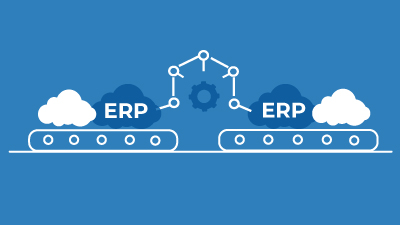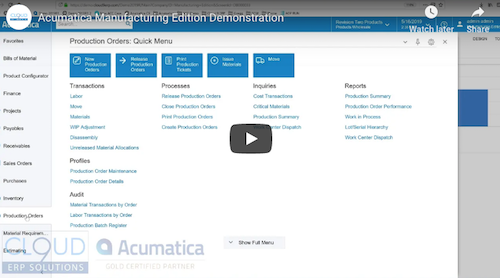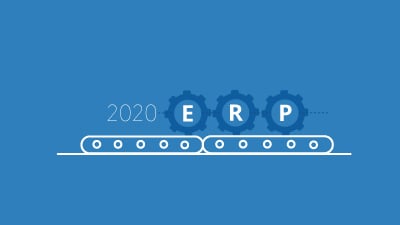8 Ways to Know if Your Manufacturing ERP is Really a Cloud Product

Manufacturing is the science of combining every item, process, and system so it makes a product that’s perfect. When everything needs to flow how you need it to you, you can’t handle any hiccups or disruptions—and that includes your back-office software. Luckily, more manufacturers than ever are turning to the cloud with the help of Acumatica and Cloud 9 ERP Solutions.
Why is the Cloud So Important?
Manufacturers often fall into one of two camps. Either they’ve gone all-in on the cloud, or they’re incredibly skeptical.
After all, the entire idea of the cloud is built in taking something that’s currently in your facilities and having it done somewhere else. If you’ve made it this far as an American manufacturer, that concept may sound familiar—and the connotations aren’t exactly positive.
But despite the feeling that moving to the cloud is outsourcing, the reality is a bit more nuanced. Think of your least valuable process or part. What if you could get rid of that and replace it with something more useful to your business? What if you could then make this at a lower cost, and make it with less risk of breakdown? That’s the promise of the cloud.
By choosing the cloud, you’re upgrading machinery. Now, instead of something that breaks down as much as it works, you have powerful hardware that runs reliably.
When you move your operations from legacy ERP to the cloud, you help free up your IT team from low-value work. Rather than running support, fixing broken integrations, and making repairs, your IT staff can focus on helping your business. What does this mean? It all depends on how your organization moves, but often, it means that your IT staff would have more time to work on upgrading the rest of your IT stack and less time repairing it.
But is it True Cloud? Or “Cloud”
However, as many cloud vendors have seen success, many legacy vendors have begun to offer “cloud” options. Unfortunately, many of the fake cloud products are the same old product you had. The only difference? You don’t see the server.
Imagine slapping a “made in the USA” label on a product because five percent of the product was made in the US. It’s not right. Luckily, as a manufacturer, you have an FTC standard to protect you.
Any legacy vendor can slap the cloud label on their product, and because it’s not hosted on-premises, they call it cloud. Sketchy, we know. But there are ways to tell the difference. Here are eight questions to ask to determine how cloudy your cloud really is.
1. Are You Getting Full Functionality Anywhere and from Any Device (without additional tools)?
This is a multi-part question, because pretty much everyone has an app, and with the right tools, you can access an on-premises product anywhere. But those aren’t cloud.
|
True Cloud |
Fake Cloud |
|
Desktop Experience: Go to a website, log into the site. You’re in. Mobile Experience: Log into the app. You have everything accessible. |
Desktop Experience: Fire up the VPN and virtualization platform. Hope that everything is up to date. Make changes. Hope nothing changed before you made said changes. Mobile Experience: Download an endless series of apps, each designed to complete one specific task. |
As you can see, the fake cloud product often requires another layer of complexity before you can even use it. Even worse, you can’t assure everything is happening in real time.
2. How Much Can You Personalize Your Software?
While it’s likely that legacy vendors have offered some kind of personalization, it’s rarely as much as you need. Maybe they’ve introduced something like a workspace, where the product shows you some of the information you need.
Unfortunately, that’s usually as much as they can do. True cloud offers you complete customization. With it, you’re free to customize your dashboards, reports, and workspaces to your needs and preferences.
3. How Well Can It Integrate?
Another thing that legacy vendors will promise is integration. It pays to ask a few follow-up questions. How tight are the integrations? How well do these integrations hold up over the course of updates? How big is the pool of integrations (i.e. can we integrate with anything we may need?)?
Many legacy vendors have APIs, but unfortunately those APIs were built at a time when updates were rare and when code was mostly proprietary. True cloud relies on resilient, modern, and open APIs that are easy to use and ready for the rapid pace of change.
Your cloud ERP solution should “meet you where you’re at” by allowing you to connect all your current tools to the system. Don’t settle for a solution that will force you to rekey years of data before you move forward.
4. What’s the Barrier of Entry for Customization and Reporting?
Legacy ERP was built in the wild west of coding languages. Often using either outdated or proprietary language, this makes customization or reporting an awful experience for all those involved. Cloud solutions were built to be customized and connected, so their languages are user-friendly.
If the vendor is not clear about how the software was written, what tools were used, how it will be customized, and how it will be integrated with other cloud systems, then you can assume they’re not using current techniques, software tools, and standards.
5. How Are We Charged?
One of the big shifts from on-premises to the cloud was the move from licenses to subscription fees. Long ago, this required you to buy per-user, whether or not you used it. Early cloud platforms kept this mentality, often relying on per-user subscriptions. Though more flexible than legacy licenses, they are still not buyer-friendly.
Per-user pricing is particularly unfair to manufacturing companies, which often need to add large numbers of occasional users to their systems. Look for a vendor that only charges for the computing power you actually use, regardless of your number of users.
6. Is It Safe?
One of the biggest boogeymen used to describe the cloud was always “it’s not safe.” Well, for the most part, that was a lie. Data centers take steps well beyond what you can accomplish to protect data, and cloud providers often deliver some of the highest-security protections. Whether that’s facility security or software security, the cloud has been proven to be much safer.
Your vendor must protect your data in a data center that meets the highest data and access security requirements. It should be a large, well-known facility that has the necessary resources for load balancing, backup and recovery, and security.
7. Okay, It’s Safe. But We Still Want to Deploy On-Premises. Is That Possible?
More of a cloud-vs-cloud discussion, but nonetheless, it pays to have options. For many manufacturers, deploying ERP in the cloud and letting their vendor host it is the most cost-effective and secure option. But your company may be different. If so, look for a vendor that also gives you the option of deploying on your own servers.
8. How Much of a Hassle Is It to Upgrade?
Good question, and if you haven’t made the move to a cloud product, you likely haven’t seen the sheer frequency by which updates occur. Now, you may think to yourself, “Twice a year?! That sounds awful.” Well, as we discussed above, APIs are resilient and customizations are easy. Updates no longer break everything—in fact they rarely break anything.
Better yet, cloud updates are about as hands-off as you can get. Maybe you check to see if everything is good to go in sandbox mode, then walk in one morning to better software.
Legacy software was painful and costly to upgrade because you had to rewrite all your customizations for the newest version of the software. A good cloud manufacturing solution will upgrade quickly and easily without disruption to your business. In fact, in a true cloud SaaS model, the software provider handles all of that for you.
Look for the True Cloud Label
When it comes to manufacturing-specific ERP, you need a solution that works for you, and a solution that’s configured to your exact needs and processes. Only true cloud solutions deliver. So whenever you’re in the market for cloud ERP, be sure to look for the true cloud label.
How can you be sure it’s true cloud? We invite you to download the free true cloud guide from our friends at Acumatica here.
Whether you’re outgrowing your current software, finding that your legacy systems aren’t ready to handle your needs, or you’re looking for something more suited to your processes and needs, the right advice, assistance, and support can make or break your ERP journey. At Cloud 9 ERP Solutions, we understand the challenges that manufacturers face in selecting ERP software, and have supported companies just like yours throughout their journey. Take the first step by watching our Acumatica Manufacturing demo:
Also, check out our on-demand webinar. How to Modernize Manufacturing Operations features Melody Moccia, Director of Administration at Emery Winslow Scale Co., who will discuss her company’s journey to the cloud, exploring how the move to Acumatica helped Emery Winslow overcome the challenges of outdated ERP. Watch now.
Additonal Manufacturing Resources
Top 9 Manufacturing ERP Software Modules
The Importance of Automation in Manufacturing ERP
Benefits of True Cloud ERP for Discrete and Batch Manufacturing



